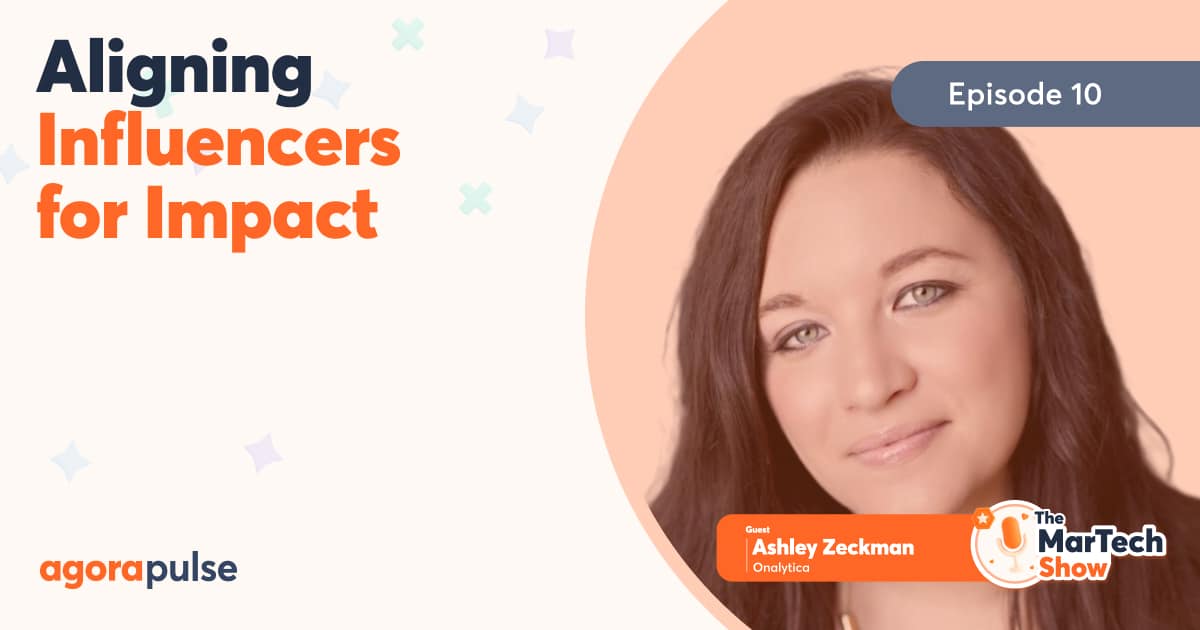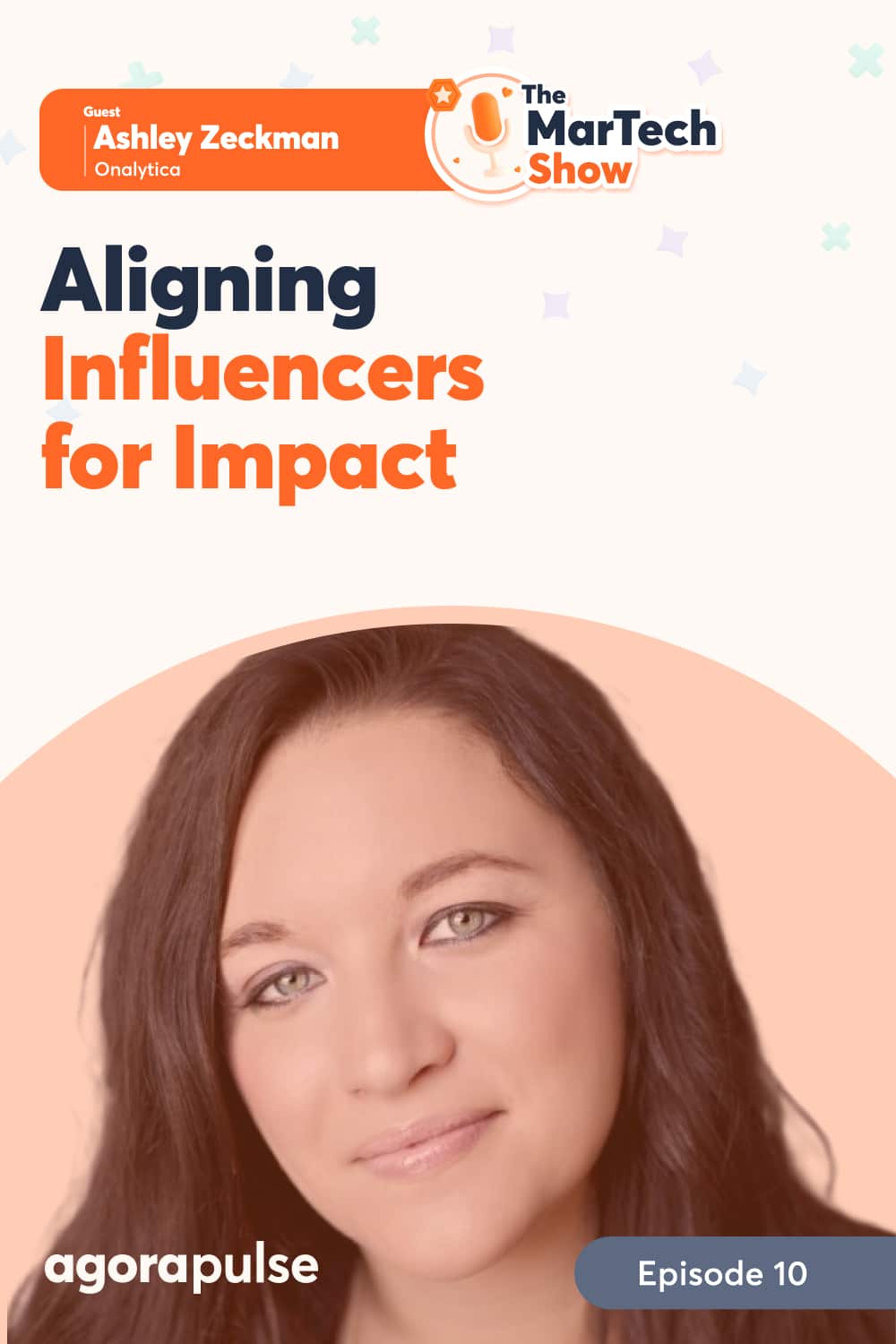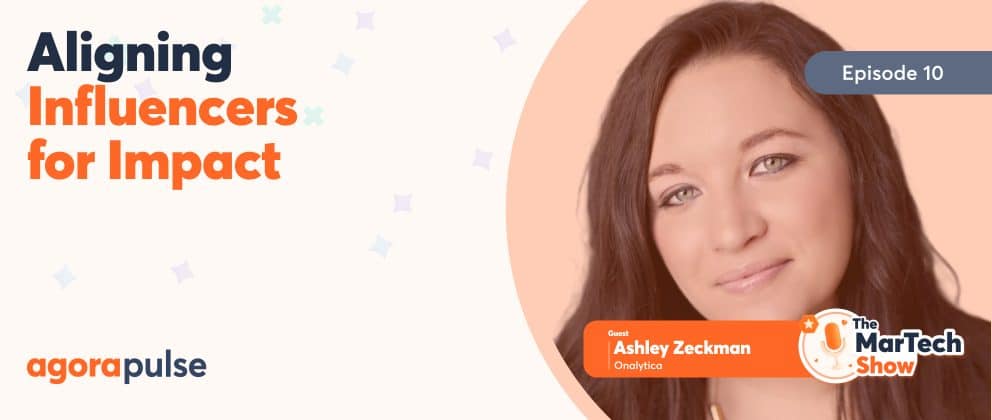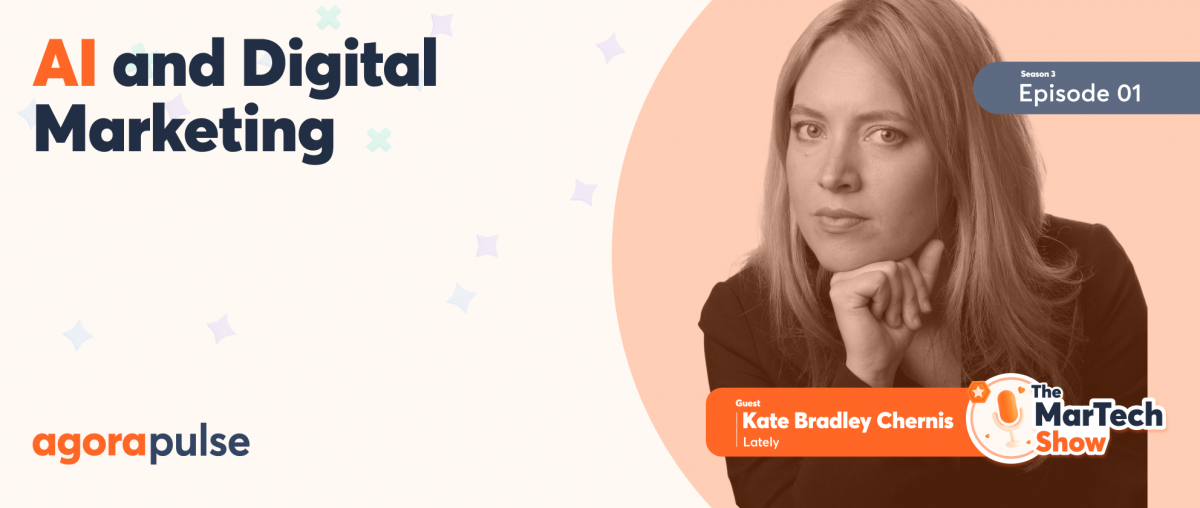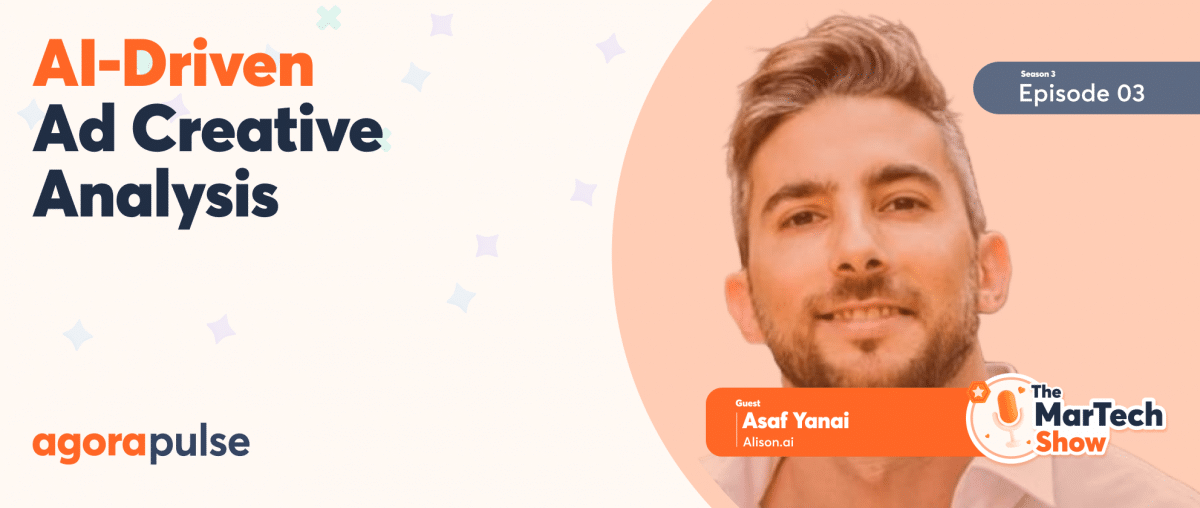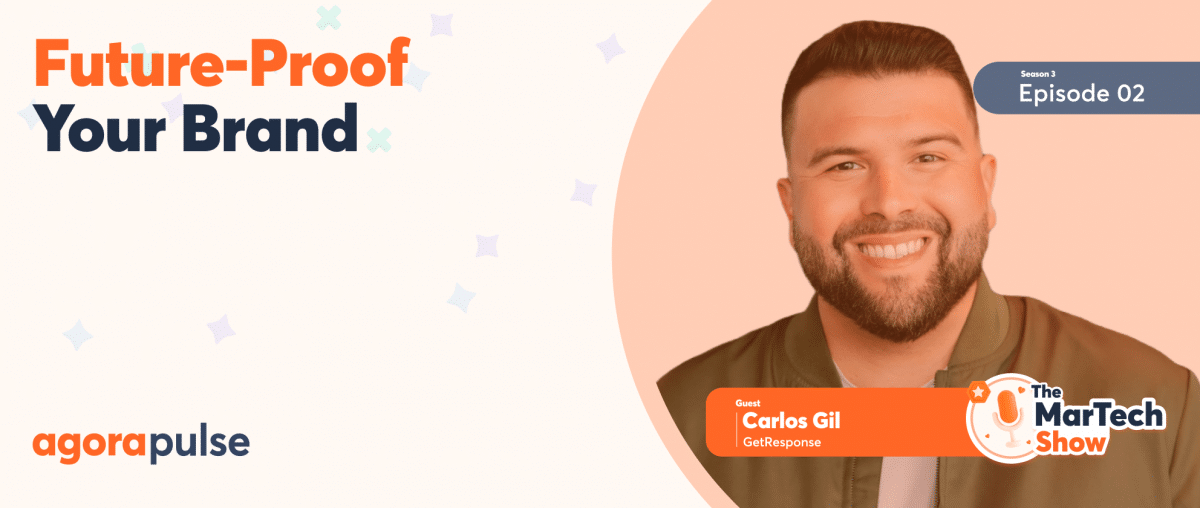Struggling to get influencer marketing working for your business? Businesses today face the complex challenge of effectively aligning their brands with influencers to truly connect with their audiences. Despite rising investments in influencer marketing, many companies struggle to ensure their collaborations are strategically sound and resonate authentically with their target demographics. Misalignment can lead to inauthentic content, wasted resources, and failed campaigns.
Imagine launching a campaign that falls flat because the influencer’s message doesn’t resonate or—worse—is perceived as disingenuous. It not only damages the campaign but can also tarnish the brand’s reputation.
How do we find and select influencers and get them aligned with our marketing strategies? That’s what we’re covering in today’s episode of the MarTech show.
Welcome back to the MarTech Show, where Robin Dimond and Mike Allton get to dish on what’s shiny and new in the MarTech space, then do a deep dive into a specific platform or solution that can help you and your business today.
[Listen to the podcast or read the transcript below.]
Mike Allton: So glad to be here. So great to see you. We’re on this new biweekly schedule with the MarTech show. And that’s one thing I miss: seeing your face every single week. So we’ve got to fix that.
Generative AI News
A fascinating report dropped this week from Forrester called the State of Generative AI Inside U.S. Agencies 2024. That’s a bit of a mouthful, but more than three-quarters of respondents said that generative AI is a disruption for their agency. 29% of respondents said it’s a major disruption that’ll change their business forever.
Respondents identified four key areas of an agency’s ecosystem where generative AI will have a significant or very significant impact:
- How an agency creates content at 76%
- The agency marketplace is at 71%
- How consumers interact with the work created by an agency at 69%
- What content agencies produce for clients at 62%
Remarkably, 91% of US advertising agencies are either currently using AI that was 61%, or they’re exploring use cases at 30 percent for that tech, outpacing other groups, including marketing organizations and the general business population.
What’s your take, Robin? Is that in line with what you’ve seen in the industry or even within your agency?
Robin Dimond: 100%. It is, and we keep talking about this, and more and more things are coming out and some people are scared of it. Yes. And some AI is scary. And if you’re not embracing it, there are not even enough hours in the day. And so we are seeing that merge of people embracing it, bringing it in, and leveraging it across everything. Plus, how can you keep up with how much content is going out there? And so this is a great way to help your teams become stronger.
Mike Allton: Could not agree more. I concur that it’s something we’ve talked about a lot. And we’re going to continue to talk about it on this show for sure.
Now, while AI influencers continue to rise in interest and usage, most brands and agencies are still turning to flesh and blood influencers to engage their audiences and build relevant connections, which means most brands still struggle with the challenges of finding, vetting, building relationships with and managing human influencers who are creative and even independent.
How do we even get started with such a complicated and nuanced discipline?
That’s exactly what Ashley Zeckman is going to talk to us about. Ashley is a dynamic marketing leader and the co-CEO at Onalytica, a company renowned for its expertise in influencer marketing and audience intelligence. With years of experience in guiding brands through the complexity of influencer collaborations, Ashley has played a crucial role in developing strategies that align brand goals with audience expectations. Her work focuses on creating authentic, engaging, and effective marketing campaigns. Ashley is also an influential voice in the marketing community, regularly sharing her insights through articles and presentations, some of which I’ve had the extreme pleasure of seeing live. So, folks, I know we’re in for a real treat today.
Onalytica Origins
Mike Allton: Could you start just telling us more about Onalytica and your role there?
Ashley Zeckman: Yeah. I mean, I think Onalytica has been around since before I think we even had the term B2B influencer marketing, and it was an organization that I’d run into in my experience working agency side as well. I’d say that we are very unique in the marketplace and that we’re a combination of consultancy. So we have supporting influencer marketing services, and we also have a platform. So we’re that combo of SaaS and consultancy that most agencies or platforms can’t offer.
Again, what we’re focused on is helping people discover, manage, and measure influencer relationships, and influencer programs. My role as the co-CEO is fairly new, and it’s a combination of things like strategic direction, vision, and steering the organization as a whole.
But I’m a practitioner through and through, so I enjoy working on a smaller, more agile team. I’m still able to dig into those marketing strategies and things that motivate me.
But I’d have to say that, honestly, my favorite part is finding the right ways to highlight the work that our team does. I’m surrounded by incredibly talented, experienced people and I get to learn from them every day. And I love that.
Can you tell us why strategic alignment between brands, and influencers is so important for marketing success?
Ashley Zeckman: I’m probably going to sound like a broken record here because I’ve been saying this for probably the last four or five years, but it comes down to building trust and authenticity.
We know that people do not trust marketers, they do not trust brands—they trust experts within our industry. So, part of what we need to look at is finding influencers that align with the same core values, the same messaging, and the same topics, which believe it or not, a lot of brands will go out to people/influencers who have never spoken on the topic of, let’s say, AI, and try to collaborate with them on something like that.
So it is important to understand who their audience is and what type of content they produce to create that more genuine, engaging, impactful program.
Mike Allton: I’m glad you brought that up because it’s one of those things where it almost sounds obvious if we’ve been doing this for a while. “Why would you approach an influencer to talk about AI if they’d never talked about AI before?”
But there might be other things that are going through people’s minds when they’re going through this, particularly if it’s an agency or a business, or maybe a social media influencer manager, who is not used to working with influencers, and they’ve perhaps been thrown into that role.
What might be some common pitfalls that you’ve seen that they could avoid when working with influencers?
Ashley Zeckman: I think two main ones come to mind for me.
- The first is treating influencer relationships as transactional. A lot of times, when we first began speaking with prospects or brands just exploring this for the first time, it’s almost like they think influencer marketing is affiliate marketing. You create a piece of content, you give someone a tracked link, and they promote it, and then you pay them based on that sort of performance. But that’s not what successful influencer marketing looks like. So, again, it’s a combination of being too transactional and not building for the long term. View these as, again, just short-term gains instead of long-term relationships. I was talking about it a little bit earlier in terms of aligning with the influencers, which means that you should understand their audience, what their audience cares about, and the values alignment.
- And then I’d say another pitfall is not aligning your tactics for your info and your influencers to the program with your objectives. So a program designed to drive awareness looks much, much different than one that’s lead gen focused. So everything, again, from the types of content you’re creating, the influencers you choose, and the way that you’re measuring it—it varies based on what you want to achieve.
Robin Dimond: You’re so transparent, and you’re so authentic, and everyone can hear it in your voice. I think that’s why Mike and I love you. And it’s amazing when you’re looking at 2024, and we’ve been doing this forever, the 2024 B2B influencer marketing report.
What are the top trends and strategies that brands need to align on? Because you are talking about that authenticity. What do they need to align on?
Ashley Zeckman: The things that we’ve already talked about, right, in terms of authenticity, long-term relationships, but I think the channels and the types of content that we found, and again, what’s unique about this report I feel that differentiates it from others in the industry is that we didn’t just survey the brands—we surveyed the influencers as well. And so we were able to overlay that data and compare and contrast a few things. So, the channel types of content are interesting.
Also, I’d say that brands are more interested in how what we want to call them. More like remote collaborations like this versus influencers are more interested in speaking opportunities, events, workshops, and things like that.
I would venture to say that’s probably likely because they can garner higher fees for those types of engagements.
But at the end of the day, there was very, very close alignment on which channels they were focusing on.
The one that was interesting to me, though, that didn’t quite fit in the mix was Threads. So influencers are much more interested in building their network there, and brands aren’t quite ready to explore it yet. But LinkedIn, YouTube, Instagram, and even TikTok are all emerging as B2B strategies.
Then, of course, AI. You can’t do any sort of research these days without thinking about how AI is going to impact the industry and the future of what we do. And I know that was something you mentioned at the beginning, Mike, was AI influencers.
Mike Allton: ‘Cause there’s no question that it will. It’s just a question of how, and that’s awesome that you’re doing this webinar with Chris, we’ll dig up the link to that, and we’ll include that in the show notes as well. But you mentioned TikTok and the kinds of platforms, derivative content, and generative content. There’s all these different questions that I think brands have.
How do they determine which platforms and content types may be most effective for their influencer collaborations?
Ashley Zeckman: That’s a good question.
I think one of my favorite takeaways from the report was something that Daniel Guzman of Marsh McLennan said, which is that you need to meet your audience where they are. So it’s going to look a bit different for every brand.
As we’re looking at B2B tech specifically, LinkedIn is the standout channel that’s most important to people right now, as well as creating content on their website. Because lead gen (as marketers, we know) is becoming more important than ever. When it was typically just a demand gen person’s role to generate leads, now it’s something we’re all responsible for. But overall, I think it’s just understanding where your audience spends the most time and what type of content. This isn’t about what you want to create. It’s about what they want to learn.
Being able to predict that by doing voice-of-customer (VoC) research or just analyzing demographic behavior—things like that will help surface which channels and platforms are going to perform best in testing.
In my opinion, there always has to be room to test, to try new things, to see what works, to see what doesn’t, and to see what your audience responds best to.
Mike Allton: This isn’t about what you want to create. It’s about what your audience wants to learn. Love that, Ashley.
Could you share some insights on the financial aspects of working with influencers, and how brands can maximize their ROI? People love talking about that. Tell us how.
Ashley Zeckman: It’s still, again, we’ve been doing this for a long time, but it still can feel a bit like the Wild West out there.
- There’s no regulation necessarily on what influencers can charge for different things. So, it could be even with one individual influencer, they might charge Company A one amount, and Company B another amount. And we see this [with] a lot of the influencers that we work with, which is why we did, as part of the report, ask a question about the influencer’s compensation expectations.
- Certain collaborations are going to cost more, and they tend to be more of those in-person events, event coverage, webinars, workshops, and even LinkedIn Live sometimes.
- But the other interesting thing is that it varied a lot based on the tier of influencers. So you would expect that, let’s call them tier-one influencers, the most well-known people in the industry, would be charging the most for things. Those tier-two influencers that are charging more.
- That was one of the things that was interesting to me because it didn’t necessarily match my hypothesis on who I thought would charge the most for what sort of things. But, ultimately to manage costs a little bit better and determine ROI, it’s important to identify again and have some small investments at first. Test with influencers, and see if they’re generating the results. And of course, to do that, you need to set up proper goals, tracking, UTM codes, and things like that can attribute ROI to influencer marketing.
Another tip is as we’re looking at more long-term relationships, figure out what things you can bundle together when you’re working with influencers. So instead of having an influencer just do a webinar or just attend an event or just do a podcast episode, figure out if there’s a long-term agreement that feels mutually beneficial, where everyone’s bringing a little bit of something to the table.
Influencers are much more likely to negotiate with you if they feel like there’s some longevity in the relationship for them.
Mike Allton: A quick follow-up question cause you mentioned something that I also found very shocking you said those tier-one influencers tended to charge less than the ones below. I would typically refer to them as a mega influencer versus a macro influencer.
Was your report identifying different verticals or industries? And if so, was that the same across those industries? In terms of what the influencers were charging for what they were doing?
Ashley Zeckman: During the influencer survey, we asked how long they’d been doing influencer work, approximately what their audience size was, and then what topics they were focused on.
So we didn’t necessarily go into it because a lot of influencers work across multiple industries, especially those in tech, but it was interesting to use that data to segment to hypothesize and then segment and see what the results were. And I’d say it was the tier-two and the tier-three who were both charging a bit more, and they tended to be the people with fewer years of experience with obviously smaller networks too.
That part was interesting and something as a follow-up that I’m digging into with some of the individual people who contributed just to get a better understanding of why they’re charging, what they’re charging, and maybe there’s someone who drives good outcomes. So they can charge.
Maybe it is more niche influencers that are very focused and specific topics that can generate better ROI sometimes. So it gave me the next step of data to explore and figure out.
Mike Allton: Yeah, because it hadn’t been my experience working with B2B marketing influencers at Agorapulse. If I want to work with Gary Vaynerchuk or Seth Godin, that would probably be at that tier-one level.
They’re way more expensive than I knew the tier 2 or tier 3 influencers that I’ve tried to work with. But then again, that’s a very nuanced and very specific.
Robin Dimond: I just find it interesting, and I actually disagree, Mike, because there is a whole podcast about mega people too scared to ask, and so they do it cheaper, so I think we’re all waiting for this information to come out. This is a follow-up we need to do with Ashley. I love it.
You talked about tracking and that is what everyone struggles with.
So what are key metrics that brands should track to ensure that their marketing efforts are aligned and effective with these?
Ashley Zeckman: I’ll say the same thing I said earlier, and that it depends on what you want to achieve.
A lot of times brands come to us and say, “I need awareness, but I also need to generate leads.” Unfortunately, as I mentioned, the type of program that you develop, the KPIs that you track, and the things that you execute differ between those two things.
So if you’re looking at awareness, it would be engagement rates, likes, shares, comments, clicks, a lot of those vanity metrics you look at online, mentions, and things like that to figure out if your content is resonating with the audience, if you’re reaching a certain audience of more people.
So what are the impressions that you’re getting by partnering with influencers? Let’s say someone with 400,000 followers, what percentage of their audience attention are you capturing that is net new for your brand?
And then as we look at conversion metrics for more demand gen or lead gen programs, we’re going to be looking at bottom-of-funnel as actual conversions. So, are we driving people to the website? Are they converting? Are they marketing qualified? Are they sales-qualified? And if you had asked me even four, five years ago, if I thought it was possible to generate leads with influencer marketing, I probably would have said no, because I don’t think we figured out how to do it right.
And we didn’t know the right types of influencers to partner with to drive leads.
So it’s been interesting the last couple of years to see how much more success we’re having in developing these different types of programs that can achieve things throughout the marketing funnel.
Mike Allton: That makes sense. And one of the things you talked about there was resonating with the audience. We’ve used that word. We used “being authentic” a couple of times.
How can brands ensure that their influencer collaborations, stay authentic, and resonate with their target audiences?
Ashley Zeckman: You are not hiring influencers to be a mouthpiece for your organization.
You are working with them because they are experts in their field. And they have the attention of the audience you’re trying to reach. The brands that edit and edit and over-edit and re-edit the content with the influencers, it makes it so much less authentic and it doesn’t make for a good long-term relationship.
We have influencers that get frustrated because they have they have something valuable to say, but it may not be promoting this product in the right way or using this is this exact right type of verbiage that a lot of times is an acronym that only exists within that organization,That most people don’t know about. And so it can be tough to consult with certain brands, especially bigger ones and highly regulated industries about why it’s important to let the influencer use their words. it’s going to be more passionate. Their audience is going to like it more and trying to control the content that they’re creating doesn’t end up usually generating the results you want anyway.
Robin Dimond: Louder for those people because that is so, that’s so true. And, and just to tone, like hone in on that again, and I think Mike said it, let the creatives be creative. If you’re going to control everything, then you are a terrible brand anyway.
And like, we have to just say that because that is where the influencers are coming. They’re, they know what works with their audience. They’re, they’re talking to them. And so I love that you said that Ashley. Mike, I know you had some questions that came in from the audience.
Mike Allton: Yeah, let’s pull in Autumn’s question. I don’t know if you have met Autumn. She’s amazing. She says:
Would you say the strategies applied to B2B influencer marketing are similar to B2C influencer marketing, or is it an entirely different approach?
Ashley Zeckman: I, especially with the rise of TikTok, I feel like B2C has started to move closer to what B2B does versus the other way around. So before it was here’s a Kardashian, here are these sneakers, here’s the ad for you to write, so be it. Versus in B2B marketing, or sorry, yeah, B2B influencer marketing, we’re focused on finding people who are experts. So there is sometimes product trade. That’s not typically part of how the compensation works, but that’s getting influencers into the product, testing the product, giving feedback, promoting it being people who might actually be users of this and promoting it to their audience versus Kardashians aren’t experts in sneakers necessarily,
So I’d say that the key difference is, is working with people who are actual experts, but. Again, it is interesting seeing the shift B2C is making where it is more, a bit more consultative. they are trying to find people who have certain expertise versus just someone with a large following who’s famous for being famous.
Could you provide some examples of successful B2B influencer marketing campaigns and maybe the strategic alignments that were made to make it work?
Ashley Zeckman: This is like pulling from 10 years of my memory bank of doing B2B influence marketing. I say, one of the programs I’m most proud of to this day, even though I haven’t had a hand in running it for a few years, was the LinkedIn Marketing and LinkedIn Sales influencer program that we started probably in, I want to say like 2016 maybe. And what was unique about that program is that they did it the right way. LinkedIn (because they’re LinkedIn) could have just gone out and asked anyone for anything.
And most people would have done it because that’s the brand association that they want. However, we focused on building relationships with the right people, nurturing those relationships, having briefings with them to understand what they cared about, and inviting them to exclusive events that were just for them was yes, they co-created content with a brand, but they also got new sizzle reels for speaking. they got access to things that no one else had access to. And the fact that that was always on and it wasn’t just a pilot or a campaign.
I think that’s where I struggle with a lot of brands, especially those just beginning is that it is so campaign-focused, when it should be something that’s, there’s always something that’s, even if it’s behind the scenes happening. So that’s one that I’m incredibly proud of.
We also have another client who works for, let’s call them a challenger brand, who very recently (I’d say within the last year) came to us, wanted to run a pilot, had never executed influencer marketing before, but they did it the right way. They built long-term relationships. They honed in on their topics. They didn’t try and do everything. They focused, and I think it was in only a few short months. They increased their engagement by 9,000%. They had an engagement rate of almost 4.9 percent on LinkedIn, which I think typical is what about 2%. And they had an incredibly low cost per conversion cost and cost per click.
So we worked with them on figuring out the ROI. “So you paid this much to work with this influencer. This is what you got. How does that compare to your other paid or organic tactics?”
And in the end, the best part about it is that they generated hundreds. In hundreds of thousands of new pipelines with what I would consider to be a very modest budget. And again, this is a challenger brand. This is not the Dells, the SAPs, the Googles, all of whom we also work with. It is not those household names. So what they were able to achieve in partnership with our team was amazing.
Mike Allton: Those are stunning stories, and I love the advice that you laced into some of those stories about approaching the program and the campaign and the influencers correctly building long-term relationships. That is advice that I give over and over and over again.
Could you share any other advice with the brands who are watching or might be listening to the podcast later on when it comes to setting up those influencer programs and achieving more alignment, whether it’s with the influencers themselves or internally as a brand?
Ashley Zeckman: I’d say piloting is very popular right now, especially with a tactic like B2B influencer marketing. There aren’t necessarily dedicated teams. It’s sometimes the ROI is not proven within an organization. So even if you’re going to be pilot-focused versus going all in, I’d say you can start short term, but think long-term from the very beginning.
Testing is great. Piloting is great. But you also don’t want to go too small working with just one influencer to do one thing. There are a variety of different factors that could impact it that might not make for the best experience. So then you might say, “Well, this isn’t for us. This doesn’t work for our brand, for our industry, whatever.” When in actuality, you need to look at how you can integrate influencers into the marketing plans that you’ve already created.
Let’s say you’re doing a white paper or an ebook. Can you include a forward from a well-known influencer? Can you include quotes throughout, as supporting content, as a way to begin engaging people?
I think it’s that, and then getting certain things into the market fast.
A lot of times, again, if we’re campaign-focused, we might be three or four months in before anything even goes live. And then by that time, you aren’t quite sure. I’d say execute some small things to begin with, leading up to a larger piece of content, a larger event, whatever that might be—so that you’re able to incrementally show ROI and make that business case, so when it comes time to have a conversation with your stakeholders, you have a good idea of what might work.
You have some results to show that aren’t just focused on one thing, and you have a good idea of which influencers might be a better fit for you long-term.
Mike Allton: That’s all we’ve got for today, folks. Don’t forget to join the Social Pulse Community on Facebook where we’re having these kinds of conversations all the time.
Thank you for listening to another episode of the MarTech show hosted by Robin Diamond and Mike Alton powered by Agorapulse, the number one rated social media management solution, which you can learn more about at Agorapulse.com.
If you want to make sure you’re part of our audience during live weekly broadcasts, take a look at our calendar at agorapulse.com/calendar, or click the subscribe button in your email once you register for any of these events, is there a particular tool or topic you’d like to see us talk about? Or perhaps you think your solution should be featured. Email at mike@agorapulse.com.
